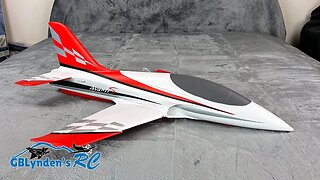Giant Scale Top Flite North American B-25 Mitchell WWII Bomber RC Plane at Warbirds Over Whatcom
This video features a Giant Scale Top Flite North American B-25 Mitchell WWII Bomber RC Plane at Warbirds Over Whatcom. I waited all day to get some footage of this beauty and the wait was well worth it to see this Top Flite B-25 go!
Link to similar RC Planes: https://bit.ly/3Uio952
The links in this description are affiliate links. They give me a small commission on sales which helps support the channel and keep it independent: https://www.amazon.com/shop/gblyndensrc
Visit https://www.gblynden.com/ to learn more about the hobby!
RC Accessories:
- Spektrum Smart Checker: https://bit.ly/329hl12
- Spektrum IX20 Radio: https://amzn.to/3qFTbHe
- Spektrum AR620 Receiver: https://bit.ly/3Aay021
Other Fun RC Planes:
- Arrows Husky 1800mm PNP STOL RC Plane: https://bit.ly/3v3qQM9
- Arrows BAe Hawk EDF Jet: https://bit.ly/2VY0HB7
- Arrows T-33 EDF Jet: https://bit.ly/3h3Z24a
- Arrows F-86 EDF Jet: https://bit.ly/3hIli3C
- Arrows F-15 EDF Jet: https://bit.ly/3Cxi10D
- Arrows RC MiG-29 EDF Jet: https://bit.ly/2ZDmjBY
- Arrows RC Marlin EDF Jet: https://bit.ly/2LUe4cN
- Arrows T-28 Trojan RC Warbird: https://bit.ly/2LOr3N4
- Arrows Bigfoot RC Plane: https://bit.ly/2TJliVh
Here is some history on this plane via Wikipedia for those of you who are not familiar with it:
The North American B-25 Mitchell is an American twin-engine, medium bomber manufactured by North American Aviation. It was named in honor of Major General William "Billy" Mitchell, a pioneer of U.S. military aviation. Used by many Allied air forces, the B-25 served in every theater of World War II and after the war ended many remained in service, operating across four decades. Produced in numerous variants, nearly 10,000 Mitchells rolled from NAA factories.[1] These included a few limited models, such as the United States Marine Corps' PBJ-1 patrol bomber and the United States Army Air Forces' F-10 reconnaissance aircraft and AT-24 trainers.
Following a number of additional modifications, including the addition of Plexiglas dome for navagational sightings to replace the overhead window for the navigator and heavier nose armament, de-icing and anti-icing equipment, the B-25C WWII Warbird entered AAF operations. Through block 20 the B-25C and B-25D differed only in location of manufacture: C series at Inglewood, California; D series at Kansas City, Kansas. After block 20 some NA-96 began the transition to the G series while some NA-87 acquired interim modifications eventually produced as the B-25D2 and ordered as the NA-100. NAA built a total of 3,915 B-25Cs and Ds during World War II.
Although the B-25 was originally designed to bomb from medium altitudes in level flight, it was used frequently in the Southwest Pacific theatre in treetop-level strafing and missions with parachute-retarded fragmentation bombs against Japanese airfields in New Guinea and the Philippines during WW2. These heavily armed Mitchells were field-modified at Townsville, Australia, under the diirection of Major Paul I. "Pappy" Gunn and North American tech rep Jack Fox, These "commerce destroyers" were also used on strafing and skip bombing missions against Japanese shipping trying to resupply their armies.
The B-25 Mitchell Bomber first gained fame as the bomber used in the 18 April 1942 Doolittle Raid, in which 16 B-25Bs led by Lieutenant Colonel Jimmy Doolittle attacked mainland Japan, four months after the bombing of Pearl Harbor, which resulted in the US joining World War Two. The mission gave a much-needed lift in spirits to the Americans, and alarmed the Japanese, who had believed their home islands to be inviolable by enemy forces. Although the amount of actual damage done was relatively minor, it forced the Japanese to divert troops for home defense for the remainder of the war.
The raiders took off from the carrier USS Hornet and successfully bombed Tokyo and four other Japanese cities without loss. Fifteen of the bombers subsequently crash-landed "en route" to recovery fields in eastern China. These losses were the result of the task force being spotted by a Japanese vessel, forcing the bombers to take off 170 mi (270 km) early, fuel exhaustion, stormy nighttime conditions with zero visibility, and lack of electronic homing aids at the recovery bases. Only one B-25 bomber landed intact, in Siberia where its five-man crew was interned and the aircraft confiscated. Of the 80 aircrew, 69 survived their historic mission and eventually made it back to American lines.
-
 7:43
7:43
GBLynden's RC
7 months agoNew Jet Unboxing | Arrows RC Avanti S 50mm EDF Jet
177 -
 1:58:54
1:58:54
Kim Iversen
9 hours agoUrban Warfare Expert Praised by RFK Jr. and Netanyahu Defends Israel's Civilian Protection in Gaza | w/ John Spencer
78.5K132 -
 5:05:59
5:05:59
Nerdrotic
11 hours agoACOLYTE FINALE! Deadpool 3! Woke Hollywood COPE | Friday Night Tights 311 / MauLerYT StarWarsTheory
121K58 -
 1:38:59
1:38:59
Glenn Greenwald
10 hours agoAfter RNC: Which Part of the Party Will Trump Embrace? The Dem Party's Growing Civil War; Scandal at WaPo Involving Neocon Max Boots and his Accused Spy-Wife | SYSTEM UPDATE #301
108K294 -
 1:52:43
1:52:43
2 MIKES LIVE
8 hours ago2 MIKES LIVE #93 OPEN MIKE FRIDAY!
47.7K14 -
 1:14:29
1:14:29
Edge of Wonder
11 hours agoGlobal Cyber Attack? & Mandela Effect Disney Tinker Bell Intro Doesn’t Exist
67.4K30 -
 57:14
57:14
The StoneZONE with Roger Stone
8 hours agoDemocrats Panic As Trump Delivers Historic Unity Speech At RNC | The StoneZONE w/ Roger Stone
66.6K34 -
 3:58
3:58
John Rich Official
11 days ago"Revelation" by John Rich featuring Sonya Isaacs
174K229 -

MissesMaam
11 hours agoGrinding Achievement + Perfection | Stardew Valley 💚✨ pt. 38
102K13 -
 59:17
59:17
Lee Camp
14 hours agoBREAKING: Yemen Strikes Tel Aviv! + US Declares Aid Pier FINISHED
100K